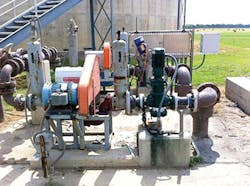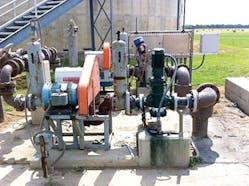By Alec Mackie
Treatment plant managers face difficult choices when it comes to breaking down debris that slips past bar screens and clogs the treatment process. Should they allow their crews to clean out the residue by hand, or should they install machines to address the problem? It can be difficult to decide on a solution that will yield both short- and long-term benefits.
Dual-shafted sludge grinders offer unparalleled solids reduction capabilities and should be installed even before sludge pumps clog or centrifuges are switched offline. Grinders help pre-condition sludge and prevent unplanned maintenance on expensive sludge pumps and dewatering systems. More importantly, they eliminate the safety risks that operators face from removing debris by hand.
There are two types of sludge pre-conditioners: the high-speed, single-shafted macerators that blend sludge into smaller pieces; and slow-speed, high-torque, dual-shafted grinders, such as JWC's Muffin Monster®, that slice debris into smaller pieces. The latter cuts through tough debris more reliably because it has three-times the torque and five-times the cutting force of the macerator.
The high-speed macerators often come with more frequent maintenance intervals and decreased reliability in demanding applications. As the following case studies indicate, selecting a dual-shafted grinder for solids reduction can lead to improved performance and a longer service life, and eliminates hand deragging.
Case #1: Coeur D'Alene, Idaho
The treatment plant in the city of Coeur D'Alene, Idaho, was experiencing continual problems with two sludge macerators, in part because of the durability of the macerator. During design, the max PSI rating was misread as 150 -- while the macerator's true max pressure rating is 30 PSI. Eventually, one of the macerators exploded and flooded the underground pump area with sludge. The accident took about 12 hours to clean up.
The crew pulled a Muffin Monster grinder from their back-up stock, which resolved the sludge issue immediately. Impressed with the performance and quality of the grinder, the plant manager requested approval to purchase three additional 10K series Muffin Monsters. With the macerators, operators were performing maintenance every 120 hours (every five days). With the Muffin Monster, however, the team can perform a simple visual inspection every few weeks, and the plant has not yet experienced any issues with ragging or backups.
Case #2: Shertz, Texas
For many years, a water reclamation plant in the city of Shertz, Texas, was able to operate with six double disc sludge pumps. In 2011, the facility, which treats an average of 6 million gallons per day (946 m3/h), underwent an expansion and added high-speed sludge macerators ahead of each pump, with the hope of combatting wipes and other tough non-dispersibles and preventing pump damage caused by debris. However, shortly after startup, the macerators were unable to handle the solids, and the pump suction lines continually plugged, leading to frequent pump rebuilds.
In order to cut through rags, hair and other tough waste, the plant would have to take the system offline two to three times per day. This wore down the macerator blades, requiring constant replacement. After dealing with these problems for a year, the maintenance superintendent searched for a reliable sludge grinder and chose the 10K series Muffin Monster. This proved crucial to protecting the plant's solids handling system and, after a few months, three more Muffin Monsters replaced the remaining macerators. Since the installation, there has not been a need to stop the system or rebuild the sludge pumps.
The nature of waste is changing, primarily due to an increase in debris entering treatment plants. Protecting pumps and systems with reliable, efficient, dual-shafted grinders provides numerous immediate and ongoing benefits. From increased operator safety and energy savings to reduced downtime and maintenance, choosing a dual-shafted grinder is a sound investment that leads to years of trouble-free operation.
About the Author: Alec Mackie is the marketing manager for JWC Environmental and has 12 years of experience in the solids reduction and removal industry.
More WaterWorld Current Issue Articles
More WaterWorld Archives Issue Articles




